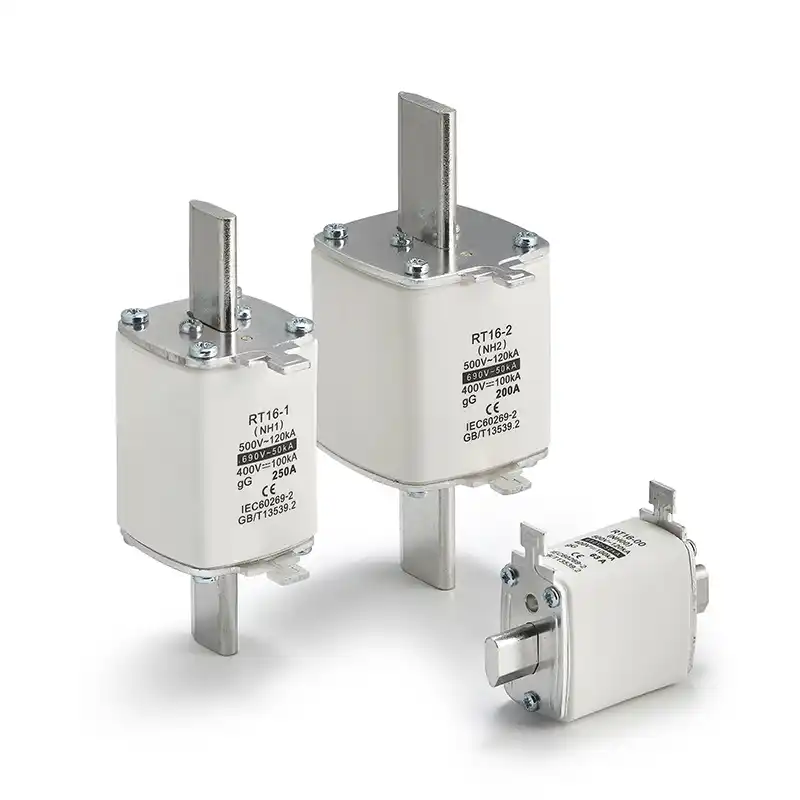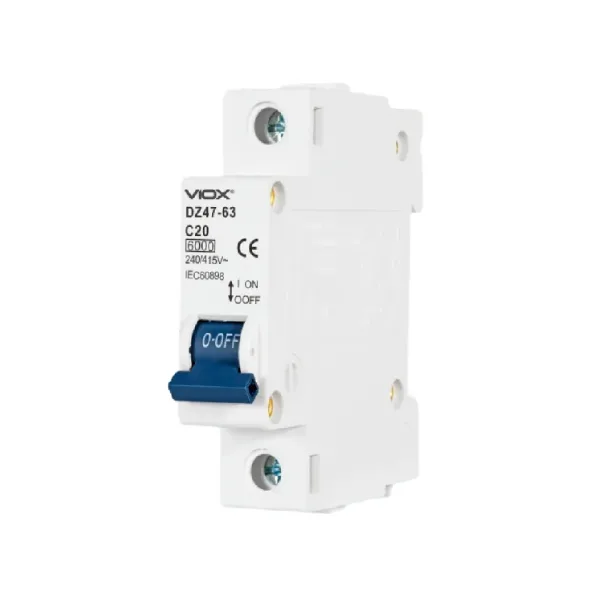It’s 2 AM on a Tuesday. Your production line just went dark—again.
You rush to the electrical room, and the culprit is exactly what you feared: another blown fuse in the VFD panel. That’s the fourth one this month. Each incident costs your plant $8,000 in lost production, delays customer orders, and puts your maintenance team on edge. Your plant manager is demanding answers, and your electrician is frustrated because “we replaced it with the exact same fuse last time.”
Here’s the problem: the fuse isn’t failing—your protection strategy is.
You’re caught in the oldest dilemma in industrial electrical systems: should you keep replacing fuses, or is it time to upgrade to a Miniature Circuit Breaker (MCB)? Most engineers make this decision based on upfront cost or what’s already in the panel. But the real answer depends on three factors you probably haven’t calculated: your load’s inrush behavior, your facility’s true fault current, and the hidden cost of downtime.
By the end of this article, you’ll have a systematic three-step method to choose the right protection—and you’ll understand why that “simple fuse replacement” might be the most expensive thing in your electrical room.
Why Your Circuit Protection Keeps Failing: The Two Mistakes Engineers Make
Before we dive into MCB vs. fuse selection, let’s diagnose why you’re here in the first place. In 15 years of troubleshooting industrial electrical systems, I’ve seen the same two mistakes cause 80% of recurring protection failures:
Mistake #1: You’re protecting the wrong thing.
Most engineers size their overcurrent protection to prevent nuisance tripping during normal operation. So when a 50 HP motor has a 65A Full Load Amps (FLA) rating, they install a 70A fuse with some margin “just to be safe.” But here’s the issue: on startup, that motor pulls 6-8x its FLA—that’s 390-520A of inrush current for 2-3 seconds. If your fuse has a fast-acting melting curve, it interprets this as a fault and sacrifices itself. Your protection worked exactly as designed—it’s just designed wrong for your load.
Mistake #2: You’re ignoring the hidden safety cost.
Every time a fuse blows, someone has to open an energized panel, verify the fault is clear, and replace the fuse element while standing inches from live bus bars. The National Safety Council reports that electrical contact is involved in 12% of workplace fatalities in industrial settings. MCBs eliminate this exposure entirely—you reset from outside the panel. But most cost comparisons never factor in this risk.
Principala concluzie: “Your protection device should match your load’s personality, not just its nameplate rating. A resistive heater and an inductive motor both might draw 50A steady-state, but they need fundamentally different protection curves.”
The Two Philosophies of Circuit Protection: Sacrifice vs. Reset
Now that you understand why protection fails, let’s talk about how each technology approaches the problem. Think of it like this:
Fuses: The Sacrificial Bodyguard
A fuse is designed to die so your equipment can live. Inside that ceramic tube is a precisely-engineered metal link—typically silver, copper, or aluminum—with a calibrated weak point. When fault current flows, the link heats up faster than your circuit wiring and melts in 2-5 milliseconds, opening the circuit before damage occurs downstream.
The advantage? Speed. Fuses are the fastest overcurrent protection available. For sensitive electronics or situations where you need to limit let-through energy (the amount of destructive energy that passes through during a fault), nothing beats a current-limiting fuse.
The disadvantage? Single-use. Once blown, you need a replacement. And if you don’t have the exact same rating on hand—or worse, someone grabs a 30A fuse for a 15A circuit because “it’s close enough”—you’ve just turned your protection device into a fire hazard.
MCBs: The Intelligent Guardian
O MCB is a resettable switch that uses two mechanisms to detect problems:
- Thermal Protection (the slow guard): A bimetallic strip heats and bends during sustained overloads, tripping the breaker in 1-60 seconds depending on the overload magnitude. Think of this as your “intelligent fuse”—it knows the difference between a motor starting up and a legitimate overload.
- Magnetic Protection (the fast guard): An electromagnet senses massive short-circuit currents and trips instantly (20-50 milliseconds). Not quite as fast as a fuse, but fast enough to prevent arc flash and equipment damage in most applications.
The advantage? Reset and forget. No inventory of spare parts. No technician exposure to live terminals. No risk of installing the wrong rating.
The disadvantage? Slower and pricier. MCBs cost 3-5x more than fuses upfront, and their reaction time is 10-20x slower during extreme short circuits.
Principala concluzie: “Fuses protect at the speed of light, but MCBs protect your technicians. Every fuse replacement puts hands near live bus bars rated for 480V or higher. That 18-millisecond speed difference won’t matter if you’ve eliminated the human risk entirely.”
The 3-Step Selection Method: Match Protection to Your Reality
Stop choosing based on what’s already installed or what’s cheapest. Here’s the systematic approach that eliminates 90% of protection failures:
Step 1: Identify Your Load’s Personality (And Its Worst Behavior)
What you’re solving: Different loads have different “surge personalities.” Get this wrong, and you’ll either nuisance-trip constantly or fail to protect during real faults.
How to do it:
1. For resistive loads (heaters, incandescent lighting, basic wiring):
These draw steady, predictable current with no startup surge. Simple math applies here.
- Fuse choice: Standard fast-acting or time-delay fuse rated at 125% of continuous load
- MCB choice: Type B curve (trips at 3-5x rated current) for residential/light commercial
2. For inductive loads (motors, transformers, solenoids):
These are the troublemakers. Inrush current can be 6-10x the running current for 2-5 seconds during startup.
- Fuse choice: Time-delay (Class RK5 or Class J) rated for motor FLA using NEC Table 430.52
- MCB choice: Type C curve (trips at 5-10x rated current) for most motors, or Type D (10-20x) for high-inrush applications like large transformers
3. For electronic loads (VFDs, computers, LED drivers):
Sensitive to voltage sags and require fast fault clearing to prevent damage.
- Fuse choice: Current-limiting Class J or Class T—these limit let-through energy to protect semiconductors
- MCB choice: Type B or even Type Z (2-3x trip) if nuisance tripping isn’t an issue
Pro-Tip: “Before you pull out the catalog, grab a clamp meter and measure the actual inrush during three consecutive startups. I’ve seen ‘identical’ motors from different manufacturers vary by 40% in inrush current due to rotor design differences. Real data beats nameplate calculations.”
Exemplu de calcul:
You have a 25 HP, 460V motor with 34A FLA.
- Inrush current: 34A × 7 = 238A (typical for 2-3 seconds)
- Fuse sizing: Per NEC 430.52, use 175% of FLA = 34A × 1.75 = 59.5A → select 60A Class RK5 time-delay fuse
- MCB sizing: Select 40-50A Type C breaker (will tolerate 200-500A for startup without tripping)
Step 2: Calculate Your Fault Level (Or You’ll Regret It)
What you’re solving: Every protection device has a maximum fault current it can safely interrupt—called the interrupting capacity (IC) or breaking capacity. Exceed this, and the device can explode, showering your electrical room with molten metal and arc plasma. This isn’t theoretical—OSHA investigates dozens of these incidents annually.
How to do it:
1. Find your available fault current:
Contact your utility company for the fault current at your service entrance, or measure it using the transformer impedance method:
Formula:
Fault Current (A) = (Transformer kVA × 1,000) / (√3 × Voltage × Impedance%)
Exemplu:
500 kVA transformer, 480V, 5.5% impedance
= (500,000) / (1.732 × 480 × 0.055)
= 10,900A available fault current
2. Match your protection’s interrupting rating:
- Siguranțe: Class RK5 fuses typically have 200,000A IC. Class J and Class T go up to 300,000A. Fuses almost always have higher IC than comparably-priced MCBs.
- MCBs: Entry-level MCBs: 6-10 kA IC. Industrial-grade: 10-25 kA IC. High-performance: 35-100 kA IC.
De ce contează acest lucru:
In the example above, a standard 10 kA MCB would be underrated for this application. You’d need at least a 15 kA model. But a Class RK5 fuse handles it easily. This is where fuses still win on paper—but keep reading for Step 3.
Principala concluzie: “If your available fault current exceeds 15 kA and you’re on a budget, fuses are still king. But don’t ignore what that ‘budget’ really costs when you factor in Step 3.”
Step 3: Calculate the True Cost (TCO Reveals the Winner)
What you’re solving: Everyone looks at the price tag. Almost nobody calculates Total Cost of Ownership (TCO) over the equipment’s 10-15 year service life.
How to do it:
Let’s compare a real-world scenario: protecting a 30A motor circuit.
| Factor De Cost | 30A Fuse | 30A Type C MCB |
|---|---|---|
| Initial Device Cost | $8-12 | $35-50 |
| Muncă de instalare | 0.5 hours = $50 | 0.5 hours = $50 |
| Spare Parts Inventory | Keep 5 spares = $50 | $0 |
| Replacement Labor (per event) | 1 hour + travel = $125 | $0 (just reset) |
| Downtime Cost (per event) | $500-5,000 depending on line | $0-100 (seconds to reset) |
| Safety Incidents (estimated risk cost) | $200/year | $10/year |
| Expected Trips Over 10 Years | 8-12 events | 8-12 events (but resettable) |
10-Year TCO Calculation:
- Fuse approach:
Initial: $62 + (10 trips × $125 labor) + (10 trips × $1,500 avg downtime) + ($200 × 10 years safety risk) = $18,312 - MCB approach:
Initial: $85 + ($10 × 10 years safety risk) = $185
You save $18,127 over 10 years by spending an extra $35 upfront.
Even if you cut the downtime estimate in half, the MCB still wins by a 50:1 margin.
Pro-Tip: “The real hidden cost? Spare fuse inventory. Fuses come in 44 different standard ratings from 1A to 600A. Stock the wrong ones, and you’re paying for overnight shipping during a shutdown. MCBs eliminate this entire headache.”
When Fuses Still Win: The Exceptions to the Rule
I’ve spent 2,000 words making the case for MCBs, but let’s be honest—fuses aren’t obsolete. Here are four scenarios where you should stick with fuses:
1. Ultra-High Fault Currents (>50 kA)
Large commercial services, utility substations, and industrial plants close to utility transformers can see fault currents exceeding 100 kA. Class L and Class T fuses handle this easily at reasonable cost. High-IC MCBs at this level cost 10-20x more.
2. Semiconductor Protection
Variable Frequency Drives (VFDs), solar inverters, and UPS systems use sensitive power semiconductors (IGBTs, MOSFETs) that can fail in microseconds. Current-limiting fuses restrict let-through energy to safe levels—MCBs can’t match this.
3. Single-Use Critical Applications
Nuclear plants, hospitals, and data centers often use fuses in critical safety circuits because they’re single-use. You want visual proof that a fault occurred (blown fuse = obvious failure mode). MCBs can fail in the closed position and give false confidence.
4. Extreme Budget Constraints
If your project has zero room for upfront cost and you have trained personnel on-site 24/7, fuses can work—but only if you’re honest about the hidden TCO trade-offs we calculated in Step 3.
Principala concluzie: “Fuses aren’t obsolete—they’re specialized tools for specific jobs. But treating them as the ‘default’ protection strategy in 2025 costs you money, time, and safety.”
Your Decision Matrix: MCB vs. Fuse at a Glance
Use this table when making your next protection decision:
| Cerere Tip | Curent de defect disponibil | Downtime Tolerance | Best Choice | Trip Curve/Type |
|---|---|---|---|---|
| Residential lighting & receptacles | <10 kA | Low | MCB | Tip B |
| Office HVAC, small motors | 10-15 kA | Low | MCB | Tip C |
| Industrial motors (under 100 HP) | 15-25 kA | Mediu | MCB | Type C or D |
| Large motors (over 100 HP) | 25-50 kA | Mare | Fuse or MCB | Class RK5 or Type D |
| VFD/Inverter circuits | Orice | Foarte scăzut | Fuse (upstream) | Class J/T current-limiting |
| Transformer primaries | 30-100 kA | Mediu | Siguranță | Class L |
| Electronică sensibilă | <10 kA | Foarte scăzut | Siguranță | Class T semiconductor |
| Utility services (>100 kA) | >100 kA | N/A | Siguranță | Class L |
The Bottom Line: Stop Choosing Based on Habit
After 15 years of diagnosing circuit protection failures, here’s what I’ve learned: most engineers choose MCBs or fuses based on what’s already in the panel, not what’s right for the application.
The three-step method eliminates guesswork:
- Match the protection curve to your load’s inrush behavior (resistive = Type B, motors = Type C/D, electronics = current-limiting)
- Verify your fault current and interrupting capacity (don’t install a 10 kA device on a 15 kA system)
- Calculate true TCO, not just upfront cost (MCBs pay for themselves in 18 months for most applications)
For 80% of industrial and commercial applications, MCBs deliver better safety, lower TCO, and eliminate downtime. But fuses still reign supreme for ultra-high fault currents, semiconductor protection, and applications where current-limiting is non-negotiable.
Următorii tăi pași
- Audit your existing protection: Walk your facility and identify circuits that trip repeatedly. Measure the inrush current with a clamp meter and verify you’re using the right curve.
- Calculate your TCO: Use the worksheet above to compare 10-year costs. You’ll be shocked at what those “cheap” fuses really cost.
- Upgrade strategically: Start with your highest-downtime circuits first. The ROI on switching to MCBs is immediate in most cases.
- Get expert sizing: If your available fault current exceeds 15 kA or you’re protecting expensive VFDs, consult with a protection coordination specialist. Wrong sizing at these levels can be catastrophic.
Need help sizing your protection? Contact our application engineering team for a no-cost circuit analysis. We’ve helped over 1,000 facilities eliminate nuisance tripping and reduce their protection costs by an average of 43%.
Întrebări Frecvente
Q: Can I replace a fuse with an MCB in an existing panel?
A: Usually yes, but verify three things first: (1) the panel is rated for MCB mounting, (2) the MCB’s IC rating meets or exceeds your fault current, and (3) local electrical codes allow the modification. Always consult a licensed electrician for the swap.
Q: Why do my MCBs keep tripping on motor startup?
A: You probably have a Type B curve installed where you need Type C or D. Type B trips at 3-5x rated current—perfect for lighting, terrible for motors. Swap to Type C (5-10x) and your nuisance trips will disappear.
Q: Are “smart” MCBs worth the extra cost?
A: If you run critical processes, yes. Smart MCBs with built-in current monitoring can alert you before a failure occurs, log trip events for root cause analysis, and integrate with your SCADA system. The upcharge is 40-60%, but the predictive maintenance value pays back fast.
Q: How do I know if my fuse is undersized?
A: Two signs: (1) it blows repeatedly under normal operation, or (2) it shows discoloration or heat marks on the holder. If you see either, you’re either undersized or have a loose connection creating resistance heating.
Rețineți: The best circuit protection is the one that matches your load, tolerates your fault levels, and costs you the least over its lifetime—not the one that’s cheapest at checkout. Choose wisely, and that 2 AM phone call might finally stop.





